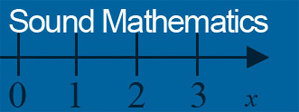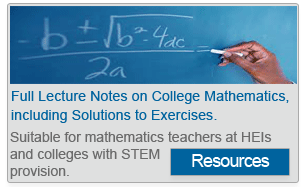A systematic approach to teaching and learning of college maths/math
Common misconceptions
At college level maths is simply a language for describing relationships between measurable quantities. It is best learnt when presented in a systematic way. Contrary to a common misconception adults can learn this language much faster than children: It is very logical and adults can rely on their experience of logic better than children.
Another common misconception is that ordinary people find it difficult to understand abstract concepts. Again, when presented in a systematic way, most ordinary adults find basic mathematical abstractions understandable and helpful. Practice shows that they learn much faster and retain knowledge much longer when – rather than learning by rote – they are shown the underlying logic of the course and thus various connections between the underlying concepts.
This type of learning still requires students to do a considerable amount of self-study and exercises – but less so than the standard approach. It can succeed only if the teachers keep reinforcing the students’ mathematical skills throughout the course – or students do it themselves. Of course, once the skills become hard-wired into the students’ brains there is no need for conscious recollection of all the connections and students begin to function as ordinary competent users of mathematics.
Competence through comprehension
Developed over 16 years in a UK University of widening access/broadening participation, the mathematics teaching and learning techniques we advocate are deeply rooted in the best educational practices tried over the centuries, adapted to modern conditions and supported by modern pedagogical findings. They lead to competency the fastest possible way – through comprehension. Once students become competent users of algebra, pre-calculus and calculus they significantly increase their chances of success on STEM courses.
The methodology is geared towards STEM students, increasing their engagement and therefore retention. It rests on two corner stones, Socratic Dialogue and Eulerian Sequencing.
Socratic Dialogue
Socratic Dialogue is a process of systematic inductive questioning used to lead a learner to knowledge through small steps. It has been repeatedly shown to be best suited for teaching those with poor motivation and since the 1990s has been used to revolutionise US undergraduate physics teaching. We believe it can revolutionise the teaching of college algebra and basic calculus. It provides instant feedback to both teacher and learner, increases learner engagement and reduces the need for testing.
Contrary to a widespread belief, Socratic dialogue can be practised in large classes. We can show
you how.
Eulerian Sequencing
Eulerian Sequencing is a systematic approach to teaching mathematics as a language in a way first promoted by Euler (see Bibliography). It focuses on teaching learners to sequence mathematical expressions and solution steps. Sequencing shows learners not only WHAT they are supposed to do but also WHY. This is important because it has been shown that the amount learnt is proportional to the number of self-explanations learners can generate.
Contrary to a widespread belief, it is not that hard to teach explanatory reasoning.
We can show you how.
Bibliography
1. Anderson, J. R., Reder, L. M. and Simon, H. A. “Applications and Misapplications of Cognitive Psychology to Mathematics Education”, Texas Educational Review, 2000 Summer.
2. Chi, M. T. H. and VanLehn, K. A. “The Content of Physics Self-Explanations”, J of Learning Sciences, Vol 1, No 1, 1991, pp 69-105.
3. Collins, C. “Teaching reasoning skills.” In Chipman, S., Segal, J. & Glaser, R. (Eds.). Thinking and Learning Skills. Vol 2. 1985, pp 579-586.
4. Cox, W. “On the expectations of the mathematical knowledge of first-year undergraduates”, Int J of Math Education in Science and Technology, Vol 32, No 6, 2001, pp 847-861.
5. Craig, S. D., Sullins, J., Witherspoon, A. and Gholson, B. “The Deep-Level Reasoning-Question Effect: The Role of Dialogue and Deep-Level-Reasoning Questions During Vicarious Learning”. Cognition and Instruction, Vol 4, No 4, 2006, pp 565-591.
6. Hackman, G. “Six pedagogical Measures and Socratic facilitation". In Enquiring minds: Socratic dialogue in education” (Eds. Saran, R and Neisser, B), 2004.
7. Hake, R. R. “Interactive-engagement vs. traditional methods: A six-thousand-student survey of mechanics test data for introductory physics courses”, American Journal of Physics. Vol 66, 1998, pp 64-74.
8. HEFCE, “Strategic Plan 2006-11”, 2007 Available online: www.hefce.ac.uk/media/hefce1/pubs/hefce/2009/0921/09_21.doc
9. Budd, K., Caron, E., Garelick, B., Klein, D., Milgram, R. J., Raimi, R. A., Schwartz, M., Stotsky, S., Williams, V. and Wilson W. S. “Ten myths about mathematics and why you shouldn’t believe them”, 2005. Available online: http://gideonlearning.wordpress.com/2011/12/28/ten-myths-about-math-education-and-why-you-shouldnt-believe-them/
10. Sangwin, C. (Ed.), Euler “Elements of Algebra”, Tarquin Publications, 2006, pp 300. Available on line: http://web.mat.bham.ac.uk/C.J.Sangwin/euler/index.html
11. Gardiner, A., “A Draft School Mathematics Curriculum for All Written from a Humane Mathematical Perspective, Key Stages 1 – 4”, The De Morgan Journal, Vol 2, No 3, 2012, pp 1-138.
Available on line: http://education.lms.ac.uk/wp-content/uploads/2012/02/KS_1-4_DMJ.pdf




